The original idea
The first UNISAT (University Satellite) was created by the GAUSS Group of Astrodynamics of the School of Aerospace Engineering (Scuola di Ingegneria Aerospaziale) of the University of Rome (Università degli Studi Roma “La Sapienza”), composed by University professors, researchers and students of the School and the faculty of Aerospace Engineering.
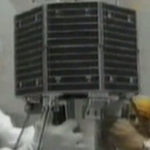
The first UniSat
GAUSS Group was led by Professor Filippo Graziani, teaching Astrodynamics at University “La Sapienza”, also member of the International Astronautical Academy (IAA), devoted to the research of orbital mechanics and attitude control subjects, with prior experience also with the San Marco Program, Sirio and ITALSAT satellites and the Thethered System on the Space Shuttle. The Group started growing, widening its activities and gaining experience in the Space Systems field, combining theoretical and “hands-on” approaches.
UNISAT Program consists of a series of artificial microsatellites for Space education representing a great change in the small satellite sector.
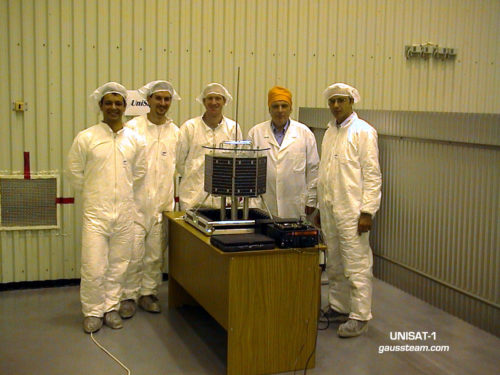
Professor Filippo Graziani and other members of the first UniSat team
Towards the Mission
Back in the 1980s, the activity of research of GAUSS Group started, developing studies on orbital and satellite systems for telecommunication and related topics.
In the 1990s the theoretical studies on building low-cost microsatellites at University developed and cooperation with other entities such as ESA, Telespazio, Universities of Torino and Napoli were developed. In 1997 the actual realization of the first UniSat started. The satellite’s design, manufacturing and testing were carried out by Phd, and (post/) graduated University students with the support of national industries and institutions such as EUROSOLARE and DMA for the manufacturing and Tests with Oerlikon-Contraves and ENEA. Some technological preparation and assemblance were carried out with Standford University’s know-how and contribution.
The Astrodynamics Laboratory for satellite design and manufacturing was established at the School, plus a Ground Station (SPIV) was set at the faculty of Engineering (in Rome).
The entire process of this first microsatellite’s creation – designing, building, launching and in orbit operations – was accomplished in the academic sphere, displayed the educational objectives and could benefit from grants by the Ministry of University and Technological Research (MURST) and the Italian Space Agency (ASI).
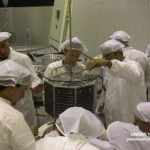
UniSat being integrated on the LV DNEPR
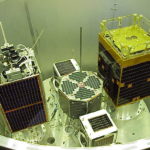
UniSat among the other smallsats launched by the DNEPR
Characteristics
- First European University Satellite
- Part of the first Cluster Launch with the DNEPR
- Shape of an octagonal prism, with size 15 x 25 cm and a weight of 12kg
- Modular microsatellite hosting scientific payloads: sensors for debris, magnetometer and camera
- Power subsystems: Solar cells – NiMh Batteries (both experiments)
- Telecommunications: UHF uplink and VHF downlink, communicating with the ground station
- OBC: a distributed computing system
- Low cost: reduced dimensions, short time to be launched, use of COTS subsystems.
Mission Objectives
- Space education and applied research: providing training to students (of aerospace engineering but not only) through a direct and qualifying involvement and increase their scientific achievements (preparation of thesis and papers, learning by doing)
- Testing technology in Space environment: the innovation is that small payloads can be placed in orbit
- Enhance Academic and Industry cooperation.
The Launch
UniSat spacecraft was successfully launched the 26 September 2000 from the Cosmodrome of Baikonur (Kazakhstan) onboard the DNEPR Launch Vehicle operated by the Company ISC Kosmotras, together with other 4 microsatellites (MegSat of Italy, TiungSat1 of Malaysia, SaudiSat-1 and 1B of the Saudi Institute for Space Research).
UniSat was injected on a circular orbit at 650 km of height and 65° of inclination.
The launch of UniSat is the first of a successful series and made “La Sapienza” the first Italian University and one of the first in the world to have launched in Space a satellite managed by students.
Hence, Microsatellites culture made its way and the concept that microsat missions can be preparatory to more complicated ones started taking roots.
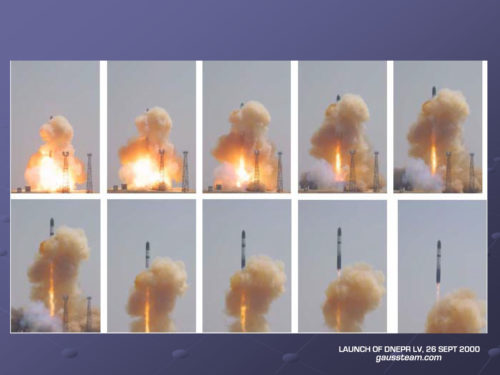
Launch of DNEPR LV on 26/09/2000 with UniSat onboard
